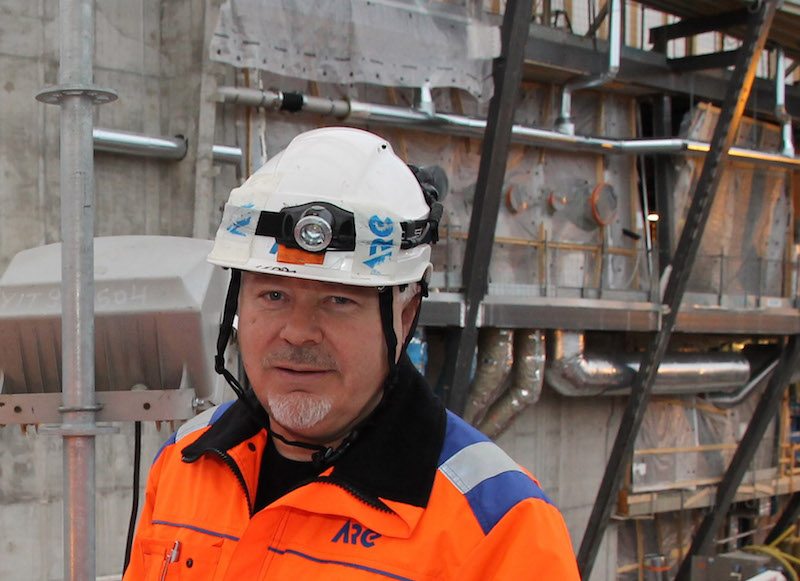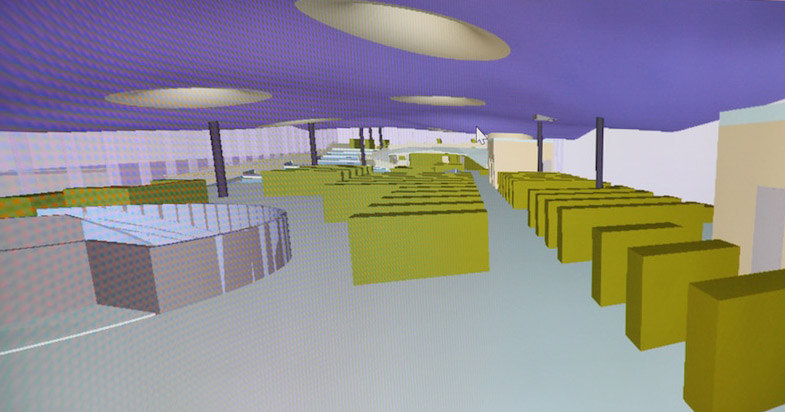If Oodi only contained books, electrical installations would be simple. But this public living room offers its guests many special premises, from a cinema to studios, which makes electrical design and installations more challenging.
“The varying shapes of the spaces also bring added challenge: each space requires a specific approach. The plan can make things look simple, but they can be a great deal more demanding in practice,” says Janne Valtonen (left), the foreman of the electricians, and Seppo Kautto (right), project manager from ARE.

Work is also made more challenging by the fact that most Oodi premises do not have the suspended ceiling structure that hides the technology. Installations are left uncovered, which is why they must be made as neatly as possible. Electrician Ari Davidila installed the black cable racks on the second floor ceiling in December.

The cinema and studios are especially challenging spaces for electricity works. Their soundproofing requires unusual solutions for the inlets of electric cables.
“The cables can’t be installed as a bundle, we have to take them through the structures one by one, like wide-spread fingers, and soundproof them individually with the paste. In addition to this, we need to follow the acoustician’s specific instructions,” says Seppo Kautto.

Due to the soundproofing, the cinema and studio premises (pictured) will be equipped with a floating floor. The red Sylomer sound absorption mat has been installed on the concrete podiums. Its purpose is to separate the overlaying surface floor from the frame structure, absorbing the studio noise and preventing noise from carrying to or from the premises.

The Living Lab with its presentation technology is also counted as a special premise.
“Special electrical inputs are needed both for projectors and the room’s glass walls that can be darkened or opened electrically with a light,” says Janne Valtonen, explaining that the building’s electrical works are in their early stages.
“Even though the basement is 60–70% complete, only about 10% of the work on the second floor is ready. We are just getting started.”

The library will take up dozens of kilometres of electric cables Some of them can be hidden under the installation floor. The installation floor stands on its own feet and it will be installed over the concrete floor so that the technology is hidden between these two layers. This makes it easy to access the cables even after the building is fully completed.
Scale model of the suspended ceiling on the third floor
Unlike on other floors, the top floor of Oodi will be equipped with a suspended ceiling. The structure will be so unique that a scale model will be made of it at first.

A computer image shows the unusual, wavy form of the ceiling and the locations of the ceiling windows. The making of the approximately 6-metre-long scale model will begin after Epiphany, and an approval from the architecture agency will be sought for it before starting the construction of the actual ceiling.

The third floor is becoming a glorious kingdom of books and light. The green bars depict the future bookshelves. Light will flow in through both the wall-high facade windows and the ceiling lights. It has been decided that the pasting work of the facade windows will be carried out under weather protection. The protective cover will be installed before Christmas and the work will be started from the northern end. The space for the large steel spiral staircase is featured on the left. The stairs will be delivered to the site at the beginning of the year.
Unisex toilet in the basement
When a building houses a cinema and a restaurant as well as meeting and working premises, it also has to have enough toilet facilities. These requirements have been taken into account in the plans.

Toilets are available on every floor, but the primary public toilet facilities are in the basement. The toilet facilities have not been divided based on gender, which means that they are unisex toilets. Visitors can access the basement both on lifts and by the concrete spiral staircase. The spiral of the staircase is almost a work of art on its own.

There are over 20 toilet cubicles in the basement, so the lines should not be too long. The sinks and seats will be installed after the floor is cast. It was completed in mid-December. The facilities have underfloor heating, which keeps the moisture levels in check.
Cleaning up the facade
The installation of the facade elements was started on the western side of the building in December.

Before starting the installation, a few element supports were modified by welding them. The steel constructions are equipped with mounts for the elements, so the elements are quick to install.

One element at a time is lifted on its supports with the help of a frame such as this. The elements will be later equipped with wooden framing to ensure that air circulates well behind the final wood cladding.

The facade will be covered similar to the pictured northern end. The 280-mm-thick ready-made elements will be covered by the wood cladding and they act as thermal insulation and vapour barrier.
New generation of worksite management
Work site managers are sought-after people on different worksites, and a new work site manager intern has also been found for Oodi: Jarno Silén, student of production management of building technology from Häme University of Applied Sciences.

“I have been interested in building and making things by hand ever since I was a child, following in the footsteps of my father and uncle. Oodi is an interesting site. I will learn a lot here,” Jarmo said on his first day of work.
